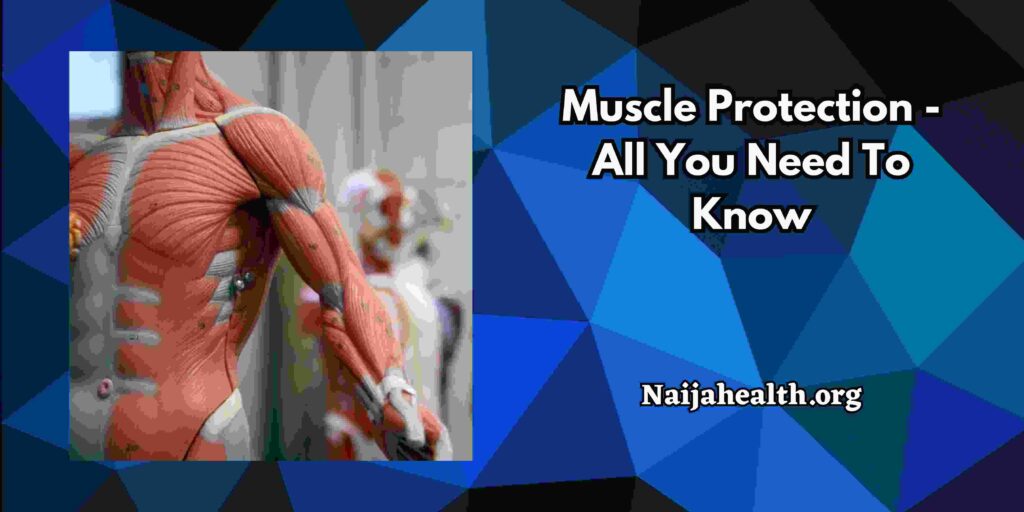
Studies Associated with Muscle Protection
Muscles play a central role in our daily lives, helping us to move, support our posture and ensure overall physical function. However, the natural aging process, sedentary lifestyle, and various health conditions can pose significant threats to our muscles, leading to muscle loss, weakness, and the ability to lose weight. operation is damaged.
This is where the concept of muscle protection comes into play – strategies and interventions aimed at maintaining muscle mass, integrity, and strength. The importance of muscle protection goes beyond aesthetics and athletic performance.
Maintaining optimal muscle health is important for people of all ages to improve quality of life, reduce risk of injury, support independent living, and improve overall health. Whether you are an athlete aiming to optimize performance or an elderly person trying to maintain functional independence, understanding the principles of muscle protection can be invaluable.
Nutritional Supplements for Muscle Protection
These supplements provide a convenient, targeted approach to supporting muscle health, aiding recovery, and optimizing performance.
In this section, we’ll explore some of the key nutritional supplements that have been widely studied and recognized for their potential benefits in muscle protection.
- Branched Chain Amino Acids (BCAAs)
BCAAs, including leucine, isoleucine, and valine, are essential amino acids that play an important role in muscle protein synthesis and repair. They are often used to minimize protein breakdown in muscle, especially during intense training or during periods of calorie restriction.
Research shows that BCAA supplementation can improve muscle recovery, reduce exercise-induced muscle damage, and support muscle protein synthesis, which in turn contributes to muscle protection.
- Creatine
Creatine is a natural compound found in meat and fish and can also be obtained through dietary supplements. It is widely recognized for its ability to improve strength and power, making it a popular choice among athletes and those involved in resistance training.
Research indicates that creatine supplementation can increase muscle mass, improve muscle strength, and aid in muscle recovery. These benefits may contribute to better muscle protection and better overall performance.
- Beta-Alanine
Beta-alanine is an amino acid that combines with histidine to form carnosine, which is found in high concentrations in skeletal muscle. Carnosine acts as an intracellular buffer, helping to regulate muscle pH and reduce the accumulation of metabolic byproducts during exercise.
By buffering acids, beta-alanine supplementation can delay fatigue, improve exercise performance, and aid in muscle protection during intense exercise.
- Omega-3 fatty acids
Omega-3 fatty acids, specifically eicosapentaenoic acid (EPA) and docosahexaenoic acid (DHA), are essential fats found in fatty fish, nuts, and flaxseeds. These fatty acids have anti-inflammatory properties and have been linked to better muscle protein synthesis, reduced muscle soreness, and improved recovery.
Omega-3 supplements can help reduce exercise-induced muscle damage and inflammation, thereby promoting muscle defense.
- Vitamin D
Vitamin D is not only important for bone health but also plays a role in muscle function and protection. Research shows that vitamin D deficiency is associated with muscle weakness, increased risk of falls, and muscle atrophy.
Adequate vitamin D levels, whether through sun exposure or supplementation, have been shown to improve muscle strength, improve balance, and reduce the risk of falls, so contributes to overall muscle protection.
Effects of Aging on Muscle Protection
Understanding the impact of aging on muscle preservation is important for developing effective strategies to minimize muscle loss and maintain strength as we age.
- Muscle mass and strength loss
One of the main effects of aging on muscle preservation is the gradual loss of muscle mass, known as muscle atrophy. Starting around age 30, individuals experience a gradual decline in muscle mass, with estimates showing a loss of about 3-8% per decade.
This loss of muscle mass is accompanied by a decrease in muscle strength and strength. Reduced muscle mass and strength can reduce mobility, increase the risk of falls and fractures, and affect overall ability to function.
- Hormonal changes
Aging is associated with changes in hormonal profiles, including a decrease in anabolic hormones such as testosterone, growth hormone, and insulin-like growth factor (IGF-1).
These hormones play an essential role in the synthesis, maintenance, and repair of muscle proteins.
A drop in anabolic hormones can contribute to the development of muscle weakness and exacerbate muscle loss and decrease muscle defenses.
- Reduced muscle quality and function
With age, the quality and function of muscle tissue decreases. Age-related changes, such as increased fat infiltration into muscles, decreased muscle fiber size, and changes in muscle fiber type composition, can negatively impact muscle function, strength, overall muscle strength and function.
This decline in muscle quality can reduce muscle protection, leaving individuals more susceptible to injury and limited function.
- Inflammation and oxidative stress
Aging is associated with chronic low-grade inflammation, known as inflammation, and increased oxidative stress. These factors can contribute to muscle damage, reduce muscle regeneration, and interfere with muscle defense.
Chronic inflammation and oxidative stress can upset the balance between muscle protein synthesis and breakdown, leading to rapid loss of muscle mass and function.
- Not physically active
As individuals age, they tend to become more sedentary, resulting in decreased levels of physical activity and muscle disuse. Physical inactivity can accelerate muscle loss and weaken muscle defenses. Lack of regular exercise and resistance training, which are important for maintaining muscle mass and strength, can exacerbate age-related decline in muscle defenses.
Strategies for Maintaining Health ad Muscle Protection
Maintaining health and protecting muscles is very important for people of all ages. Whether you are an athlete looking to optimize your performance or an elderly person looking to maintain your functional autonomy, implementing effective muscle maintenance strategies is essential.
- Resistance training
Engaging in regular resistance training exercises is one of the most effective strategies for maintaining muscle mass, strength, and defense. Resistance training involves activities that challenge muscles against external resistance, such as weight lifting, elastic bands, or bodyweight exercises.
By gradually overloading muscles through resistance training, individuals can stimulate muscle protein synthesis, promote muscle growth, and improve overall muscle health and protection. body.
- Adequate Protein
Protein is the building block of muscle and consuming enough protein is important for maintaining muscle. Try to include high-quality sources of protein in your diet, such as lean meats, poultry, fish, eggs, dairy products, legumes, and plant-based protein sources like tofu and tempeh .
The recommended daily amount of protein varies depending on factors such as age, activity level, and health status. Consulting with a dietitian can help you determine the right amount of protein for your specific needs.
- Nutritional support
Along with adequate protein intake, ensuring a balanced diet that provides essential nutrients is important for muscle maintenance. Include a variety of fruits, vegetables, whole grains and healthy fats to support overall health and optimize muscle function.
Nutrients like vitamins D, C and E, omega-3 fatty acids, and antioxidants have been linked to better muscle protection and health. Consider incorporating these nutrient-rich foods or consult a healthcare professional about potential dietary supplements.
- Active lifestyle
Maintaining an active lifestyle that includes regular physical activity in addition to resistance training can help maintain overall muscle tone. Incorporating activities like walking, swimming, biking, or playing sports promotes overall cardiovascular and physical health. Regular physical activity promotes blood circulation, oxygen supply to muscles and overall muscle function, thus contributing to muscle protection.
- Rest
Allowing for good rest is essential for muscle maintenance. Getting enough sleep, usually 7 to 9 hours a night, is important for muscle recovery and growth. Additionally, incorporating rest days into your exercise routine can prevent overtraining, reduce the risk of injury, and optimize recovery and muscle protection.
- Hormonal balance
Maintaining optimal hormonal balance is important for muscle maintenance. Hormones such as testosterone, growth hormone, and insulin-like growth factor-1 (IGF-1) play an important role in muscle protein synthesis and development. Regular exercise, managing stress levels, and adopting a healthy lifestyle can help support hormonal balance and contribute to muscle protection.
FAQs
How often should I do resistance training to maintain muscle?
Strength training should be done at least 2 to 3 times a week. This frequency provides an adequate stimulus to promote muscle maintenance and growth. However, the specific frequency may vary depending on individual factors such as fitness level, goals, and resilience. It’s important to strike a balance that allows for proper rest and recovery between workouts.
Can I maintain muscle mass and strength without using weights or exercise equipment?
While resistance training with weights or exercise equipment often involves muscle maintenance, it is still possible to maintain muscle mass and strength without them. Bodyweight exercises, such as pushups, squats, sit-ups, and planks, can be effective in stimulating muscles and promoting muscle maintenance. Additionally, resistance bands and other portable exercise equipment can provide resistance to stimulate muscles.
The key is to focus on exercises that target major muscle groups and gradually increase the intensity or difficulty over time.
How important is nutrition for muscle maintenance?
Nutrition plays an important role in muscle maintenance. Consuming adequate amounts of protein is essential to support muscle protein synthesis and repair. Try to include protein-rich foods in your diet, such as lean meats, fish, dairy products, legumes, and plant-based protein sources.
Additionally, a balanced diet provides essential nutrients, vitamins, and minerals that are important for overall muscle health and function. Consulting with a registered dietitian can help you develop a personalized nutrition plan to support your muscle maintenance goals.
Can older adults benefit from resistance training to maintain muscle?
Yes, resistance training is very beneficial for older adults in terms of maintaining muscle mass, strength, and function. In fact, with age, it becomes even more important to combat the natural decline in muscle mass and strength.
Engaging in regular strength training, even with lighter weights or modified movements, can help preserve muscle tissue, improve bone density, improve balance, and reduce the risk of falls . Seniors should consult with a medical professional or certified trainer to design a safe and appropriate exercise program.
Is it possible to maintain muscle without supplements?
Yes, muscle maintenance can be achieved without the use of supplements. While some nutritional supplements, such as protein powders or amino acids, can provide additional support, they are not essential for muscle maintenance.
A balanced diet that meets your protein and nutrient needs, along with a consistent resistance training program and overall healthy living habits, can be of great help in maintaining a healthy lifestyle. maintain muscle. It’s important to focus on whole foods as your primary source of nutrients and to consult a healthcare professional before considering a supplement.
Is it possible to maintain muscle through cardiovascular exercise alone?
While cardiovascular exercise, such as jogging, swimming, or cycling, is important for overall fitness and cardiovascular health, it may not be enough for optimal muscle maintenance. Resistance training specifically targets muscle tissue and stimulates muscle protein synthesis, which is essential for muscle growth and maintenance.
Incorporating both resistance training and cardiovascular exercise into your exercise routine can provide a holistic approach to muscle maintenance, cardiovascular fitness, and overall health.
Conclusion
Maintaining muscle health and protection is very important for people of all ages. Whether you are an athlete looking for peak performance or an elderly person looking to maintain functional independence, implementing effective muscle maintenance strategies is essential.
In addition to resistance training and good nutrition, it’s important to maintain an active lifestyle that incorporates regular physical activity in addition to resistance training. Engaging in cardiovascular exercise and staying active supports overall muscle function, blood flow, and oxygen delivery to muscles.
Allowing for proper recovery and proper rest is important for muscle maintenance. Getting enough sleep and rest in your exercise routine facilitates muscle repair and growth. Balancing hormones, managing stress, and adopting a healthy lifestyle contribute to maintaining optimal hormonal balance, which is needed to protect muscles.



Be the first to comment